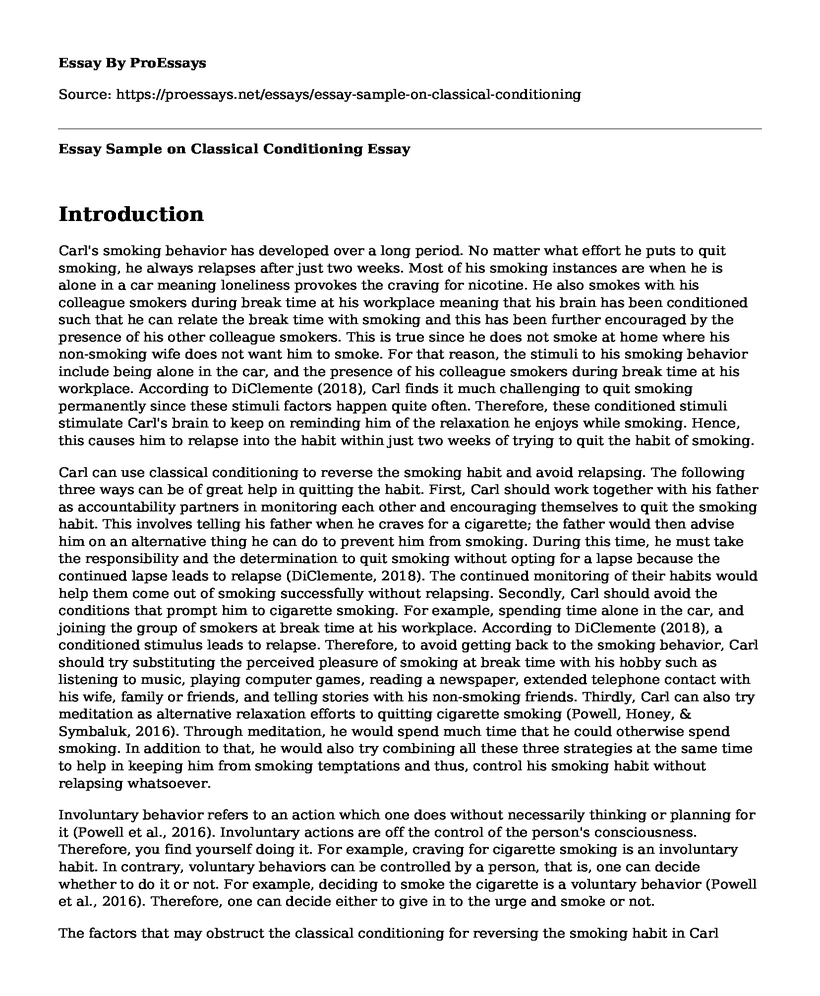Introduction
Carl's smoking behavior has developed over a long period. No matter what effort he puts to quit smoking, he always relapses after just two weeks. Most of his smoking instances are when he is alone in a car meaning loneliness provokes the craving for nicotine. He also smokes with his colleague smokers during break time at his workplace meaning that his brain has been conditioned such that he can relate the break time with smoking and this has been further encouraged by the presence of his other colleague smokers. This is true since he does not smoke at home where his non-smoking wife does not want him to smoke. For that reason, the stimuli to his smoking behavior include being alone in the car, and the presence of his colleague smokers during break time at his workplace. According to DiClemente (2018), Carl finds it much challenging to quit smoking permanently since these stimuli factors happen quite often. Therefore, these conditioned stimuli stimulate Carl's brain to keep on reminding him of the relaxation he enjoys while smoking. Hence, this causes him to relapse into the habit within just two weeks of trying to quit the habit of smoking.
Carl can use classical conditioning to reverse the smoking habit and avoid relapsing. The following three ways can be of great help in quitting the habit. First, Carl should work together with his father as accountability partners in monitoring each other and encouraging themselves to quit the smoking habit. This involves telling his father when he craves for a cigarette; the father would then advise him on an alternative thing he can do to prevent him from smoking. During this time, he must take the responsibility and the determination to quit smoking without opting for a lapse because the continued lapse leads to relapse (DiClemente, 2018). The continued monitoring of their habits would help them come out of smoking successfully without relapsing. Secondly, Carl should avoid the conditions that prompt him to cigarette smoking. For example, spending time alone in the car, and joining the group of smokers at break time at his workplace. According to DiClemente (2018), a conditioned stimulus leads to relapse. Therefore, to avoid getting back to the smoking behavior, Carl should try substituting the perceived pleasure of smoking at break time with his hobby such as listening to music, playing computer games, reading a newspaper, extended telephone contact with his wife, family or friends, and telling stories with his non-smoking friends. Thirdly, Carl can also try meditation as alternative relaxation efforts to quitting cigarette smoking (Powell, Honey, & Symbaluk, 2016). Through meditation, he would spend much time that he could otherwise spend smoking. In addition to that, he would also try combining all these three strategies at the same time to help in keeping him from smoking temptations and thus, control his smoking habit without relapsing whatsoever.
Involuntary behavior refers to an action which one does without necessarily thinking or planning for it (Powell et al., 2016). Involuntary actions are off the control of the person's consciousness. Therefore, you find yourself doing it. For example, craving for cigarette smoking is an involuntary habit. In contrary, voluntary behaviors can be controlled by a person, that is, one can decide whether to do it or not. For example, deciding to smoke the cigarette is a voluntary behavior (Powell et al., 2016). Therefore, one can decide either to give in to the urge and smoke or not.
The factors that may obstruct the classical conditioning for reversing the smoking habit in Carl include lack of openness to his father when he craves to smoke a cigarette. This would make it difficult for his father to know it and offer advice that would help keep him off smoking. Another obscuring factor to classical conditioning effect would be a lack of personal commitment to keeping off the smoking habit (DiClemente, 2018).
References
DiClemente, C. C. (2018). Addiction and change: How addictions develop and addicted people recover. Guilford Publications.
Powell, R. A., Honey, P. L., & Symbaluk, D. G. (2016). Introduction to learning and behavior. Cengage Learning.
Cite this page
Essay Sample on Classical Conditioning. (2022, Nov 15). Retrieved from https://proessays.net/essays/essay-sample-on-classical-conditioning
If you are the original author of this essay and no longer wish to have it published on the ProEssays website, please click below to request its removal:
- Antibiotics: Definition, Types, and Brief History
- Comorbidity of Fibromyalgia and Mental Illness - Research Paper
- Health Insurance in the US Essay Example
- Essay Sample on Pathophysiological and Political Causes of Coronary Heart Disease
- Essay Sample on Role of Epidemiology in Public Health
- Essay on Weight Loss Intervention for Obese and Overweight Children and Adolescents
- Essay Example on Herbal Remedies & Dental Care: Ancient Traditions







